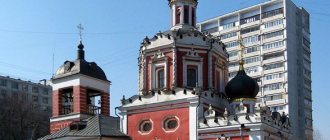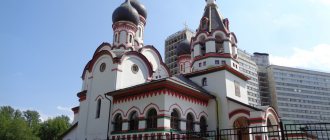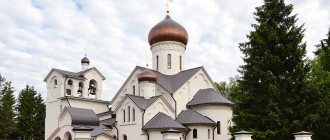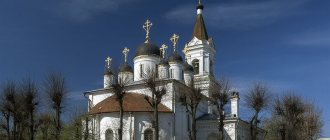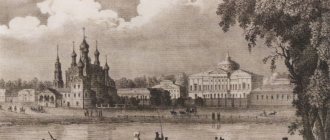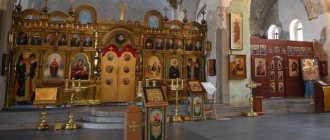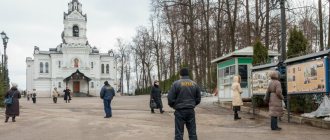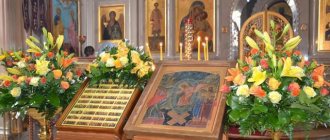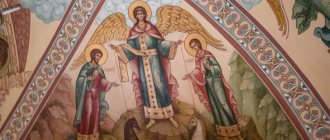| Orthodox church | |
| Church of the Life-Giving Trinity in the village of Yazvische | |
| Church of the Life-Giving Trinity | |
| 55°59′20″ n. w. 36°12′48″ E. d.HGЯOL | |
| A country | Russia |
| Village | Yazvische, Volokolamsk district, Moscow region |
| Confession | Orthodoxy |
| Diocese | Moscow |
| Architectural style | classicism |
| Date of foundation | 15th century |
| Construction | 1815-1820 |
| Status | Object of cultural heritage of the peoples of the Russian Federation of regional significance. Reg. No. 501410354650005 (EGROKN). Object No. 5000001144 (WikiGida DB) |
| State | valid |
| Website | yazvishche.moseparh.ru |
| Media files on Wikimedia Commons | |
The Church of the Life-Giving Trinity in the village of Yazvische
is an Orthodox church of the deanery of the patriarchal metochions in the Moscow region (the village of Yazvische, Volokolamsk district, Moscow region). Metochion of the Patriarch of Moscow and All Rus'; until 1999 - the courtyard of the Joseph-Volotsky Monastery[1].
The main altar is consecrated in honor of the Holy Trinity; chapels in honor of Archangel Michael, in honor of St. Nicholas.
History[ | ]
Village Yazvische[ | ]
The village of Yazvische with the Church of the Life-Giving Trinity located in it is one of the most ancient places in the Volokolamsk region. The village is located on the Gryada River, 3 km from the source of the Lama River and 20 km from Volokolamsk.
There is a version according to which the name “Ulcer” is associated with a healing spring located in the center of the village. The word “Yazvische” is translated from the ancient Slavic language as a large cave or failure. This is a translation of the Greek word "Khona" - crevice, cave. This name is associated with a legendary event - the Miracle of the Archangel Michael in Khoneh (Colossae). Through the prayers of the Monk Archippus, Archangel Michael, with a blow from his spear, opened a crevice (hona) in the ground, into which a mudflow rushed. This flood was provoked by the pagans to destroy a Christian temple, built according to a vow by a local resident in gratitude for the healing of his daughter from muteness. The original wooden temple was dedicated to the Miracle at Khoneh. The temple was rebuilt three times in the 17th–19th centuries. The ancient “Chudskaya” temple was included as a chapel.
The village is famous for the fact that in 1440 Saint Joseph of Volotsky, founder of the Joseph-Volotsky Monastery, was born there.[2]
The first mention of the wooden Church of the Life-Giving Trinity dates back to the 15th century.
Construction of the temple[ | ]
In 1815, construction of a new brick church began at the expense of parishioners. The temple was consecrated in 1820. In 1894, according to the design of S.I. Borodin, the refectory was rebuilt. At the end of the 19th century, a beautiful church fence was built with three gates and hipped turrets at the corners.
The temple was built in the style of classicism. The quadrangle of the church is crowned with a large light rotunda, covered with a dome with small lucarnes. It is adjoined to the east by a semicircular altar apse and to the north and south by four-column porticoes. An extensive four-pillar refectory connects the temple with the bell tower. The bell tower, made up of four cubic tiers, is crowned with a dome with a dome. The decorative decoration of the building is restrained. The walls of the refectory are decorated with pseudo-Russian decor, and a decorative cupola is placed above its center.
Soviet period[ | ]
From 1933 to 1937, Vladimir Medvedyuk, a future holy martyr, served in the church.
Trinity Church was closed and desecrated in 1956[3]. Most of the church valuables were looted, but some church icons were preserved. The temple building was used for a long time as a collective farm warehouse.
Church of the Life-Giving Trinity (Uzvischi)
The ancient churchyard of Yazvischi is located in the former Krestetsky district, which is now in the Okulovsky district. Its name, according to legend, is associated with the Yazvinka River, the bank slopes of which are pitted with numerous fox holes. There was once a wooden church in Yazvischi, built in 1763, and a small stone chapel at the cemetery. Fairs were organized in the village, to which up to three hundred carts came from surrounding villages. The village grew and the wooden church became small. In 1891, at the expense of wealthy parishioners from among local landowners and zemstvo leaders, a new stone church of St. was built on the site of the old church. Nicholas the Wonderworker and St. Blessed Prince Alexander Nevsky. The consecration of the temple took place in a solemn atmosphere with a large crowd of people...
For many decades, the rector of the church in Yazvischi was the Khrapovitsky and Osnitsky. In the sixties of the last century, the priest in Yazvischi was Timofey Danilovich Khrapovitsky, and after him Alexander and Yakov Osnitsky. Yakov Petrovich Osnitsky was the last priest in Yazvischi and served there for more than thirty years. His wife was Klavdia Timofeevna, née Khrapovitskaya, who in her youth was a needlework teacher at a parochial school in the village of Kayevo, 2 km from Yazvischi. Yakov Petrovich built a two-story wooden house in Yazvischi next to the church, which has survived to this day. His son Pyotr Yakovlevich Osnitsky, who was a doctor and served in the local Kaevskaya hospital, lived there until 1961.
Years have passed. The permanent population of Yazvischi disappeared, houses were dismantled and transported to other villages. And after the death of Pyotr Yakovlevich Osnitsky, who looked after the cemetery and church, their desecration began.
Sofya Konstantinovna and Ivan Yakovlevich Savich owned the Voznesenskoye estate in Kayevo. Ivan Yakovlevich was distinguished by great hard work and enterprise. Since 1863, he became actively involved in zemstvo activities, was a Justice of the Peace, a district and provincial councilor, and a member of the Provincial Council, from 1881 to 1890. Novgorod provincial Marshal of the nobility. Sofya Konstantinovna was a match for her husband - energetic, sociable, she did a lot of good deeds. So, in 1875, at the district zemstvo assembly, she made a proposal to build a hospital in Kayovo at her own expense. The site for the construction of the hospital was chosen halfway from Kaev to Yazvischi. Initially, the hospital was wooden, and in 1904, after the death of Sofia Konstantinovna, her son Yakov Ivanovich Savich built a stone building. After the revolution, for almost forty years, the chief physician of the hospital in Kayovo was the son of the priest Yakov Petrovich Osnitsky, Pyotr Yakovlevich Osnitsky, who enjoyed great love and respect among the local population. After his death in 1961, the hospital was closed. She stood under lock and key for almost thirty years. In 1991, enthusiastic doctors from St. Petersburg, the Tereshchenkovs, made an attempt to reopen the hospital, which was in perfect condition, requiring only staff and medicine. The hospital operated for only two years; the authorities did not have funds to maintain it. Now the hospital building is in a deplorable state.
The famous Novgorod zemstvo figure Pavel Pavlovich Khrapovitsky (1834-1888), his sisters Evgenia Pavlovna (1826-1912), married Yuzefovich, and Ekaterina Pavlovna (1828-1868), married Krenke, are buried in the old cemetery in the Yazvischi churchyard. Their father was Pavel Aleksandrovich Khrapovitsky (1779-1864), the son of a senator and secretary of state of Empress Catherine II. The Khrapovitskys belong to an old noble Belarusian family. In 1747, one of the representatives of this family, Vasily Ivanovich Khrapovitsky, was elevated to the dignity of nobility by Empress Elizabeth Petrovna “to reward faithful, useful and important merits.” His son Alexander Vasilyevich Khrapovitsky (1749-1801) became a famous figure in Russian history not only because he was the Empress’s secretary, but also thanks to the publication of his very interesting “Memoirs”. He was granted lands in the Nizhny Novgorod, Tver and Novgorod provinces. His son P.A. Khrapovitsky, who owned lands in Krestetsky district, was married twice. His first wife, Princess Margarita Ivanovna Ukhtomskaya (1796-1831), was the mother of Evgenia Pavlovna and Ekaterina Pavlovna, and the second, Sofya Petrovna Divova (? - 1837) was the mother of Pavel Pavlovich. Both of them also rest in the Ulcers...
Pavel Pavlovich and Natalya Petrovna had four sons: Alexander and Boris became district zemstvo leaders in Krestsy, Vladimir was a botanist, and Alexey went down in Russian history as a major church figure and writer. While still in his fourth year at the St. Petersburg Theological Academy, Alexei Pavlovich Khrapovitsky became a monk under the name Anthony. In 1890, he received the rank of archimandrite and became rector first of the Moscow and then of the Kazan Theological Academy. In 1902 he was named Archbishop of Volyn. In 1917, during the election of the patriarch, he was one of the contenders. Elected Patriarch Tikhon in the same year elevated Anthony Khrapovitsky to the rank of Metropolitan of Kyiv and Galicia. After the revolution of 1917, Metropolitan Anthony found himself in exile and, by general recognition, became one of the most authoritative spiritual leaders in the Russian emigration and headed the Russian Orthodox Church Abroad. His writings were predominantly of a religious nature. And in France, he published the book “Our Pushkin,” in which he argued, with quotations from Pushkin’s works, that in his life he became a deeply religious person. Antony Khrapovitsky died in 1936...
Now in the ruined and desecrated church of St. Nicholas the Wonderworker and St. of the blessed Alexander Nevsky, not a single grave has survived, and the temple itself, with its tormented appearance, calls for a new revival.
D. Mikhailov St. Petersburg Source:
Mikhailov D. Old cemetery in the Novgorod churchyard Yazvischi // Sofia. – 1999. – No. 4. – P. 24-25.
Mikhailov D. Old cemetery in the Novgorod churchyard Yazvischi // Sofia. – 2000. – No. 1. – P. 32-33.
According to the document “Notes of the Imperial Russian Geographical Society. Book VIII" edited by K.A. Nevolin, published in St. Petersburg (1853), in which there is a second document “On the Pyatina and Churchyards of Novgorod in the 16th century” on page 179 it is indicated that the name of the wooden church at that time: “the church in the name of the Holy Life-Giving Trinity.” It was probably preserved at the new stone temple.
In the article by Mikhailov D. “The old cemetery in the Novgorod churchyard Yazvischi” (Sofia. - 1999. - No. 4. - P. 24-25) it is stated that the church is named in honor of St. Nicholas the Wonderworker and St. Blessed Prince Alexander Nevsky. I believe that since the temple has three chapels, these are not the names of the main chapels.
The first name of the church is supported by the fact that in the collection of the Novgorod Library No. 504 “Index of churches in Krestetsky and Tikhvin districts” op.6 d.d.1-13.28 // 16 d.17, the following is indicated “pogost Yazvischi c. Trinity".
On the area map:
Recovery. Currently[ | ]
In 1990, the temple building was returned to the Russian Orthodox Church; The temple received the status of a metochion of the Joseph-Volotsky Monastery (until December 1999). In the same 1990, next to the revered source, on the site of a wooden chapel that existed in Yazvische back in the 19th century, a brick chapel was built.
Since 1991, the rector of the temple is priest Alexy Rzyanin, in 1992 Hieromonk Nikon (Belavenets) was appointed rector, since January 2000[1] the rector of the temple is priest Vitaly Khokhlov (who partially restored the temple), since December 2012 the rector is Archpriest Alexander Amelin[ 4], since April 2021, for the first time, a second full-time cleric has been appointed to the temple - Priest Ilya Solovyov[5].
- Chapel at the healing spring
An excerpt characterizing the Church of the Life-Giving Trinity in the village of Yazvische
“Vous ne daignez pas descende jusqu'a moi, vous... [You don’t deign to deign to marry me, you...],” Helen said, crying. The face began to console her; Helen said through her tears (as if having forgotten herself) that nothing could prevent her from getting married, that there were examples (there were few examples then, but she named Napoleon and other high-ranking persons) that she had never been her husband’s wife, that she was sacrificed. “But laws, religion...” the face said, already giving up. - Laws, religion... What would they be invented for if they could not do this! - said Helen. The important personage was surprised that such a simple reasoning could not have occurred to him, and turned for advice to the holy brothers of the Society of Jesus, with whom he was in close relations. A few days after this, at one of the charming holidays that Helen gave at her dacha on Kamenny Island, she was presented with a middle-aged man, with hair as white as snow and black sparkling eyes, the charming Mr. de Jobert, un jesuite a robe courte, [g n Jaubert, a Jesuit in a short dress,] who for a long time in the garden, under the light of illumination and the sounds of music, talked with Helen about love for God, for Christ, for the heart of the Mother of God and about the consolations provided in this and in the future life by the only true Catholic religion. Helen was touched, and several times both she and Mr. Jobert had tears in their eyes and their voices trembled. The dance to which the gentleman came to call Helen upset her conversation with her future directeur de conscience [guardian of conscience]; but the next day Mr. de Jobert came alone in the evening to Helen and from that time began to visit her often. One day he took the countess to a Catholic church, where she knelt before the altar to which she was led. A middle-aged, charming Frenchman put his hands on her head, and, as she herself later said, she felt something like a breath of fresh wind that descended into her soul. They explained to her that it was la grace [grace]. Then the abbot was brought to her a robe longue [in a long dress], he confessed her and absolved her of her sins. The next day they brought her a box containing the sacrament and left it at home for her to use. After a few days, Helen, to her satisfaction, learned that she had now joined the true Catholic Church and that one of these days the pope himself would find out about her and send her some kind of paper. Everything that was done during this time around her and with her, all this attention paid to her by so many smart people and expressed in such pleasant, sophisticated forms, and the dovelike purity in which she was now (she wore white dresses with white ribbons) - all this gave her pleasure; but because of this pleasure she did not miss her goal for a minute. And as it always happens that in the matter of cunning a stupid person deceives smarter ones, she, realizing that the purpose of all these words and troubles was mainly to convert her to Catholicism, to take money from her in favor of Jesuit institutions {what does she mean? made hints), Helen, before giving money, insisted that those various operations be performed on her that would free her from her husband. In her concepts, the meaning of any religion consisted only in observing certain decency while satisfying human desires. And for this purpose, in one of her conversations with her confessor, she urgently demanded from him an answer to the question of the extent to which her marriage binds her. They were sitting in the living room by the window. It was twilight. The smell of flowers came from the window. Helen was wearing a white dress that was see-through on her shoulders and chest. The abbot, well-fed, and with a plump, smoothly shaved beard, a pleasant strong mouth and white hands folded meekly on his knees, sat close to Helen and with a thin smile on his lips, peacefully - with a gaze admiring her beauty, he occasionally looked at her face and expressed his gaze to the question that was on their mind. Helen smiled restlessly, looked at his curly hair, smoothly shaved, blackening full cheeks, and every minute waited for a new turn in the conversation. But the abbot, although apparently enjoying the beauty and intimacy of his interlocutor, was carried away by the skill of his craft. The line of reasoning of the leader of conscience was as follows. In ignorance of the significance of what you were doing, you took a vow of marital fidelity to a man who, on his part, by entering into marriage and not believing in the religious significance of marriage, committed blasphemy. This marriage did not have the double meaning that it should have. But despite this, your vow bound you. You stepped away from him. What did you accomplish with this? Peche veniel or peche mortel? [A venial sin or a mortal sin?] Peche veniel, because you committed the act without bad intent. If you now, with the goal of having children, entered into a new marriage, then your sin could be forgiven. But the question again splits into two: first... “But I think,” said the suddenly bored Helen with her charming smile, “that I, having entered the true religion, cannot be bound by what the false religion has imposed on me.” The Directeur de conscience [Guardian of Conscience] was amazed at this Columbus egg placed before him with such simplicity. He was delighted with the unexpected speed of his student’s success, but could not abandon the edifice of arguments he had built with mental labor.
Notes[ | ]
- ↑ 12
The monarchist hieromonk was sent out of state // NG Religions. - 01/12/2000. - The work of the Holy Venerable Joseph of Volotsk “The Enlightener” (undefined)
(inaccessible link). Access date: July 14, 2009. Archived June 11, 2008. - Church of the Life-Giving Trinity in the village of Yazvische on russian-church.ru
- Decree No. У-01\/643 December 14, 2012 (unspecified)
(inaccessible link). www.moseparh.ru. Retrieved April 6, 2016. Archived April 20, 2021. - Decree No. U-02\/61 of April 5, 2021 (unspecified)
(inaccessible link). www.moseparh.ru. Retrieved April 6, 2016. Archived April 20, 2021.
